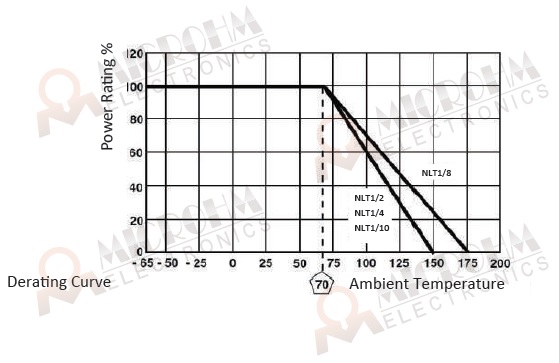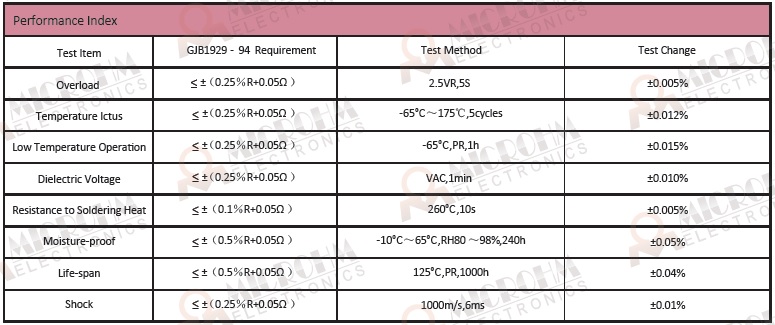Position:Home » Technical Articles
The Understanding of Key Parameters in Resistor Specs
Writer:Microhm Page View:Date:2019-07-18
Although not a complex component, resistors have specifications that can be confusing, misleading, and misinterpreted. When specifying performance qualities, it is important to review and understand the resistor test conditions to properly interpret and apply the results to your design. There are potentially significant differences in data presented by resistor manufacturers and those differences can significantly affect performance. The specification process for resistors involves more than just allowing for tolerance bands. Voltage, power, and temperature ratings can interact in ways that can degrade circuit reliability.
 The power rating and voltage rating of a resistor are one common source of confusion. Simply put, the power rating is the amount of energy the resistor can dissipate in a given time at the designated ambient temperature.Microhm Electronics Ltd. typically list multiple voltage ratings on a datasheet, but most often the primary concern is the maximum working voltage. Maximum working voltage is the maximum amount of voltage the resistor can withstand constantly without arcing. Maximum working voltage is often expressed as Vrms. Power/voltage vs. resistance for a general-purpose thick-film standard power resistor ( Only at exactly 39.68 KΩ can the 0402 resistor handle both 50 V and 0.063 W simultaneously ). This value is known as the critical resistance value.
The power rating and voltage rating of a resistor are one common source of confusion. Simply put, the power rating is the amount of energy the resistor can dissipate in a given time at the designated ambient temperature.Microhm Electronics Ltd. typically list multiple voltage ratings on a datasheet, but most often the primary concern is the maximum working voltage. Maximum working voltage is the maximum amount of voltage the resistor can withstand constantly without arcing. Maximum working voltage is often expressed as Vrms. Power/voltage vs. resistance for a general-purpose thick-film standard power resistor ( Only at exactly 39.68 KΩ can the 0402 resistor handle both 50 V and 0.063 W simultaneously ). This value is known as the critical resistance value.
Another aspect of the power rating is the temperature at which heat dissipation is measured. Many resistors are rated at temperatures of at least 70°C. This means the part can handle the designated power rating provided the ambient temperature around the part does not exceed 70°C. However, there are some higher power resistors that are only rated for full power operation up to 25°C. These power resistors typically require some type of external heat removal to operate at full rated power.

Performance specs provide information about how a resistor behaves in a test or a set of tests. Engineers will regularly use this information to compare parts from different manufacturers. For a resistor series tested to a common standard such as AEC-Q200, it is relatively easy to compare performance.
The load or bias on the resistor is a critical factor during testing. At full rated power, most resistors will generate enough heat to prevent moisture from condensing on the part, giving the appearance of robust moisture resistance. But in many applications, precision nichrome thin-film resistors will only see a fraction of their rated power. In these cases, the part will generate little heat, boosting the possibility of moisture condensing and collecting on the part.

Another aspect of the power rating is the temperature at which heat dissipation is measured. Many resistors are rated at temperatures of at least 70°C. This means the part can handle the designated power rating provided the ambient temperature around the part does not exceed 70°C. However, there are some higher power resistors that are only rated for full power operation up to 25°C. These power resistors typically require some type of external heat removal to operate at full rated power.

Performance specs provide information about how a resistor behaves in a test or a set of tests. Engineers will regularly use this information to compare parts from different manufacturers. For a resistor series tested to a common standard such as AEC-Q200, it is relatively easy to compare performance.
The load or bias on the resistor is a critical factor during testing. At full rated power, most resistors will generate enough heat to prevent moisture from condensing on the part, giving the appearance of robust moisture resistance. But in many applications, precision nichrome thin-film resistors will only see a fraction of their rated power. In these cases, the part will generate little heat, boosting the possibility of moisture condensing and collecting on the part.
Keywords:
Latest News
- Resistor's role in measuring and correcting LED,,,
- Single through-hole resistors' characteristics ,,,
- Why shunt resistors for current sense applicati,,,
- Metal-film resistors with small size, high resi,,,
- 36W High-Current Shunt Resistors MMS8420,,,
- 1W Surface Mount Resistor MPR1206,,,
- An Overview of Microhm Electronics' Resistor Pr,,,
- More anti-sulfur resistors used in harsh envir,,,
- Resistance changes with temperature,,,
- 140W TO247 High Power Heatsinkable Resistor,,,
- MMS5930 is ideal for current sensing in industr,,,
- Shunt resistors selection for engineers' design,,,
- Considerations for choosing precision resistors,,,
- Ceramic Encased Cement Resistors NWH Series for,,,
- Resistors for Passive Balancing in Battery-Pow,,,
Hot Articles
- Microhm will take part in 10th Automotive World,,,
- Thanks for Visiting Microhm's Booth E5-5706 in ,,,
- Resistors in Short Supply: Blame Cars,,,
- New lunch: High Power Precision Shunt Resistor,,,,
- How to Test a Resistor,,,
- Innovative Technology, Future Electric: Electri,,,
- What is Precision Resistors?,,,
- SMD Resistors Sizes and Packages,,,
- The Construction and Features of Metal Film Res,,,
- What is a TO-220 Resisor?,,,
- Hot Selling Products: Precision Shunt Resistors,,,
- How to Calculate the Equivalent Resistance Valu,,,
- What is a Fixed Resistor?,,,
- Resistors in LED Circuits,,,
- Resistors Types and Materials Overview,,,
Resistance applications
- BMS for New Energy Vehicle,,,
- Carbon Film Resistors' Features and Application,,,
- Industrial Roberts Applied to Solar Photovoltai,,,
- Select the Right Resistor for Harmonic Filterin,,,
- Surface Mount Resistor's Size and Package ,,,
- Shunt Resistor MMS8420 for High Current Stable ,,,
- The Four Important Functions of Alloy Resistors,,,
- Why Zero-Ohm Resistors?,,,
- The Measurement Accuracy of Automotive Shunt is,,,
- Urbanization Development Bringing the Transform,,,
- Difference Between High Precision Resistors and,,,
- The Main Application for High Precision and Low,,,
- Miniature future for passive electronic compone,,,
- Heater Blower Motor Resistor in Air Conditioner,,,
- Precision Resistors' Construction and TCR,,,
